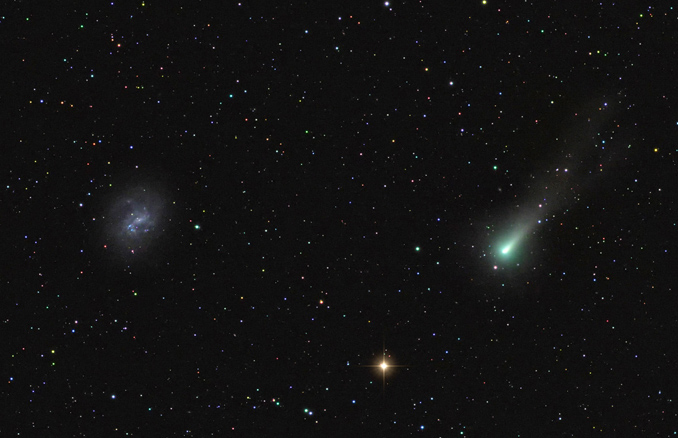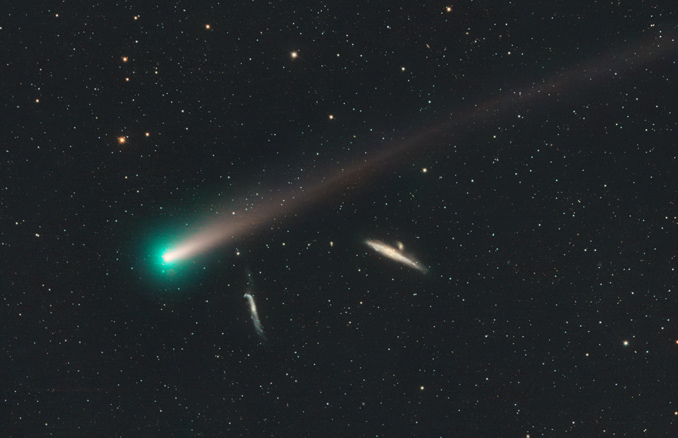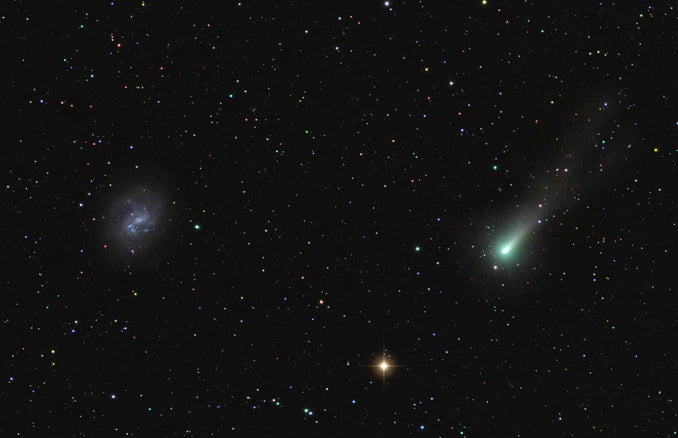Comet Leonard on course for a good showing – Astronomy Now
[ad_1]

Comet 2021 A1 (LEONARD) has now broken out of the cometary pack to brighten up and shine close to naked-eye magnitude (+7.2) at the time of writing (27 November). All the indications look good for it at the very least to become marginally visible to the naked-eye and a nice object through a pair of binoculars at some time while its accessible from UK skies during the first ten days or so December. Throughout this period of time comet 2021 A1 (LEONARD) is a morning object seen rocketing through southern Canes Venatici, Boötes, Serpens Caput and Ophiuchus, steadily accelerating as it zero’s in on a close approach to Earth on 12 December.
Comet 2021 A1 (Leonard) was the first comet discovery of 2021 (hence the 2021 A1 designation), on 3 January 2021 by Greg Leonard from Arizona’s Mount Lemmon Observatory. By quirky chance, this is exactly a year before its perihelion passage on 3 January 2022! At perihelion, comet 2021 A1 (Leonard) will lie around 92.7 million kilometres (0.61 AU) from the Sun. It was discovered out in Jupiter’s domain (~5 AU away) as a tiny smudge of light with an apparent diameter of around 10” and shining at nineteenth-magnitude. Astronomers quickly calculated that the comet will be ejected from the Solar System at some point after perihelion passage.
Comet 2021 A1 (LEONARD) comes closest to Earth on 12 December, when it will lie around 34.4 million kilometres (0.23 astronomical units) away, though it will then be a very tough spot in the pre-dawn from the UK owing to its very low position over the eastern horizon as twilight starts to gather.
The comet currently gives every indication that it’s very active. It has evolved dramatically over the past month or so, gaining around four magnitudes. Recent images, such as the marvellous image here from Michael Jäger, show it now sports an intensely green coloured coma that may have quadrupled in angular diameter (to ~16’ at its extremities), and a fine tail, the faintest traces of which stretch at least a couple of degrees away to the north-west. Visually, the coma is seen to span between 4’ to 8’, its size being dependant on aperture and local sky conditions.

You’ll have to be prepared to rise from a warm bed or be a bit of a night owl in order to see comet 2021 A1 (LEONARD). However, this doesn’t seem to me to be much of an imposition as it’s only around for 10 days or so. Also the comet is already the brightest icy visitor of the year, with potential for it to shine as bright as magnitude +4, and this is the only chance we’ll ever get to see comet 2021 A1 (LEONARD) before its unceremoniously chucked out of the Solar System.

At the start of December, comet 2021 A1 (LEONARD) lies in southern Canes Venatici close to the boundary with Coma Berenices, tracking south-eastwards by about 5” per minute relative to the background stars. By 3am GMT, the comet lies around 30 degrees clear of the eastern horizon.

There’s a real observing treat for visual observers and astro-imagers alike when on the morning of 3 December comet 2021 A1 (LEONARD) slides just south of mighty Messier 3, the great globular cluster in Canes Venatici; the pair are closest at around 4am, when the comet, which hopefully will have brightened by now to around magnitude +6, lies around 7’ south of M3. If your observing location is cloud-free for long enough and has a reasonably unobstructed view to the east, you’ll be able to see in real time as the comet’s rapid apparent motion of around 6” per minute takes it past M3 between about 2am and 6am GMT.
Comet 2021 A1 (LEONARD) enters Boötes on 4 December and lies just over five degrees north of brilliant Arcturus (alpha Boötis) on the morning of 6 December. For once the astronomical gods are smiling down upon us, as the Moon is new at around dawn on 4 December and won’t infer for the rest of the comet’s morning showing. The comet’s plunge south-eastwards means it’s losing altitude from UK skies; you’ll now need to wait an hour longer than at the beginning of December, until around 4am GMT, for comet 2021 A1 (LEONARD) to achieve an altitude of 30 degrees. By 8 December, the comet’s travelling with an apparent motion of 15” per minute and can be located in the far east of Boötes, around three degrees east of magnitude +5.4 xi Boötis. Astronomical twilight begins from London shortly before 6am GMT, with the comet around 30 degrees up. Earth crosses the orbital plane of the comet on 8 December, which will enhance the tail.
The morning of 10 December is realistically your last chance to catch comet 2021 A1 (LEONARD) while observing circumstance from the UK are still reasonable. The comet is now located in Serpens Cauda, around 5.5 degrees north-east of magnitude +2.6 Unukalhai (alpha Serpentis) and it now rocketing across the sky at over 21” per minute. If expectations are fulfilled, comet 2021 A1 (LEONARD) will be shining at around magnitude +4
Following close approach on 12 December, comet 2021 A1 (LEONARD) moves into the dusk sky a few days later and can soon be seen from the Southern Hemisphere. In Sydney, Australia, the comet can be seen from around 21 December when it lies among the stars of Microscopium, some 20 degrees high in the west-south-west at about 9.10pm AEDT (at the end of nautical twilight when the sky is reasonably dark). Its apparent motion across the sky has now dropped below 10” per minute. Comet 2021 A1 (LEONARD) steadily gains altitude in the dusk in the run-up to perihelion, entering Piscis Austrinus on 30 December.
[ad_2]
Original Post


415 thoughts on “Comet Leonard on course for a good showing – Astronomy Now”